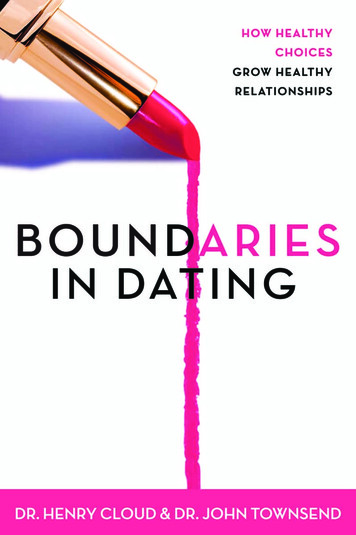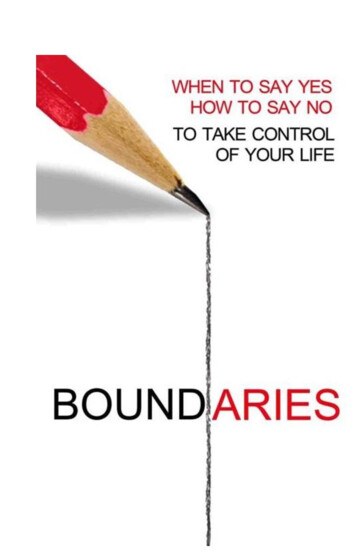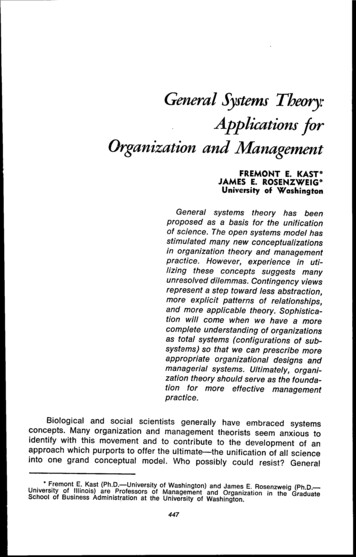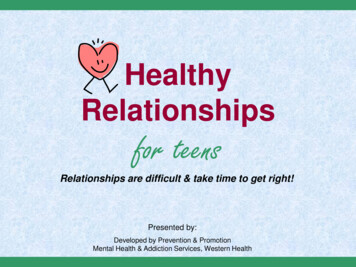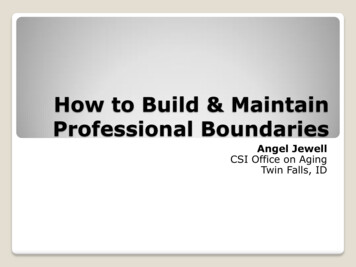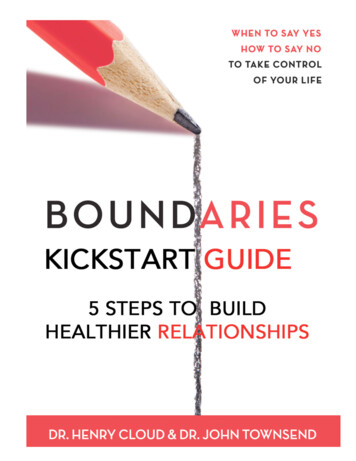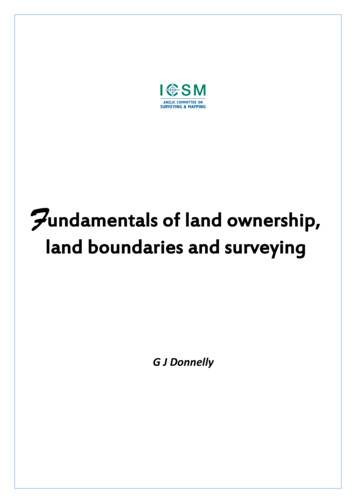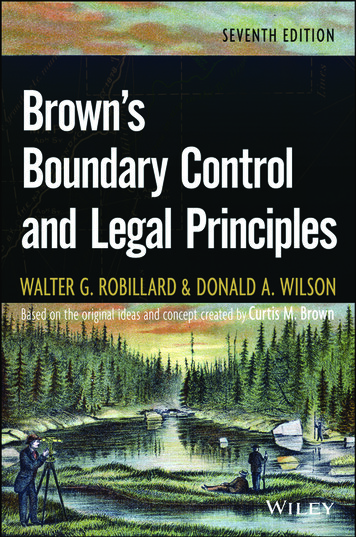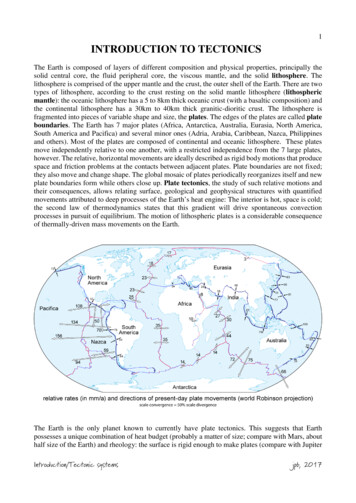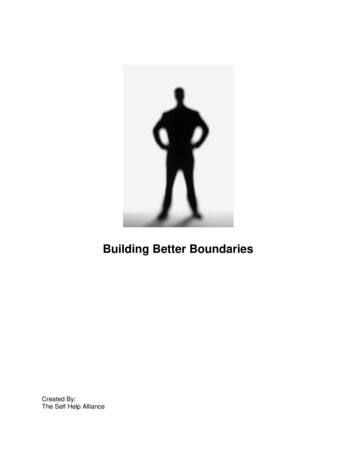
Transcription
Building Better BoundariesCreated By:The Self Help Alliance
DisclaimerTo reprint items prepared by the Self Help Alliance, the following terms apply to writtenitems and documents.Please note, you do not need reprint permission for these items, (however we dorequire that items be referenced and/or cited) if you plan to use for the followingpurposes:to improve the management practices within your organization ex. for policies,procedures, training, planning etc. You may copy items to share with internalmembers of your board, staff, etc.to include items in a publication for which there is no cost to the reader. Forexample, you may include items in a publication internal to the organization or apublication that is external to the organization and for which there is no cost.Regarding any reprint items, please include with your reprint and/or reference:Name of authorOrganizational NameCopyright dateSource of materialIf you are printing materials for a profit based purpose or anything else not referred toabove, please connect with us.If you have any questions, please do not hesitate to contact us at:p: 519.766.4315a: 5420 Highway 6 North, RR #5 Suite J100, Guelph, Ontario, N1H 6J2, CanadaWe hope that you enjoy our materials.Thank you,Self Help AllianceBetter Boundaries20102
ContentPage NumberScope / Goal / OutcomesSection One – Introduction to BoundariesSection Two – Where Do Boundaries Come From?Section Three – Boundary Types: Physical BoundariesSection Four – Boundary Types: Sexual and Spiritual BoundariesSection Five –Boundary Types: Relationship and Legal BoundariesSection Six –Boundary Types: Emotional and Mental BoundariesSection Seven – Understanding and Setting BoundariesSection Eight – Overcoming Boundary ChallengesSelf Help AllianceBetter Boundaries20103
ScopeThis curriculum duration is 12 hours (1.5 hour sessions x 8 sessions). The curriculumplan followed the Kemp (1994) Curriculum planning model and Blooms Taxonomy. Thisworkshop content was developed and will be implemented with a learner-centredapproach.GoalOn completion of this workshop learners will be able to evaluate the effectiveness oftheir current boundaries, identify various boundary types, and identify methods toenhance or create boundaries.OutcomesThese outcomes build upon the belief that everyone the potential to understand the roleboundaries play in our lives, and can develop/improve upon skills to set and maintainboundaries. Upon completion of this workshop you will be able to: Describe ways boundaries can be beneficial (Knowledge & Attitude)Identify and evaluate your own boundaries (Knowledge & Evaluation)Understand, define and evaluate different types of boundaries (Knowledge)Identify ways of respecting other‟s boundaries (Knowledge)Identify and evaluate different ways your boundaries have been set (Knowledge &Evaluation) Explore how you can begin to set or strengthen your boundaries (Knowledge & Attitude) Practice tools to maintain and strengthen your boundaries (Skill)Self Help AllianceBetter Boundaries20104
Section OneIntroduction to BoundariesLearning OutcomeCompletion of this section will enable you to: Understand the general meaning of boundaries (Knowledge) Describe ways boundaries can be beneficial (Knowledge & Attitude)Self Help AllianceBetter Boundaries20105
Boundaries Defined“Boundaries are a life enhancing system of “yes‟” and “no‟s.” They are stop signs and bordersyou install to protect yourself so that it is clear that you own your life, make good choices, andpursue the authentic expression of who you are in the way you live, love, give and relate.”“Boundaries are a limit you set between yourself and people due to thoughts, activities andthings that aren‟t in your best interest”“The first boundary I drew was between myself and my habit of saying negative things aboutmyself to others Once I got a handle on that, I moved to setting limits on names I calledmyself, like „You stupid fool‟ and „Loser.‟” Carl(Source: Black, J. & Enns, G. (1997) Better Boundaries: Owning and Treasuring Your Life.Oakland, CA. Raincoast Books)“All these boundaries - Africa, Asia, Malaysia, America - are set by men. But you don't have tolook at boundaries when you are looking at a man - at the character of a man. The question is:What do you stand for? Are you a follower, or are you a leader?” Hakeem Olajuwon“And this is one of the major questions of our lives: how we keep boundaries, what permissionwe have to cross boundaries, and how we do so.” A. B. YehoshuaWhat do boundaries mean to you and your life? If you choose, discuss your thoughtswith the group.Self Help AllianceBetter Boundaries20106
What have Boundaries Done for Me Lately?Boundaries help you to:Define Your Identity – you become clear and confident with yourself, and others knowwhat to expect from you.Protect Yourself from Violators – boundaries let in what is good and keep out what isbad, so you remain safe and able to express your true self.Bring Order – without them, you are unable to regulate demands, ideas, dreams,responsibilities, opportunities, pleasures and activities. Life can become chaotic.Promote You – leaders and employers with good boundaries know that if you havegood boundaries, you can be trusted to state clearly what you can and cannot do,welcome input and work passionately without burnout.Protect Yourself from the Control of Others – having clear boundaries makes itdifficult for others to control you, and makes it easier for you to say no when you need to.Preserve Your Purpose and Mission – once these are identified, boundaries save youfor the relationships and opportunities that best fit who you are.Protect Your Finest Personal Assets – which includes knowledge, body, skills,abilities, purpose and missionSatisfy Your Need for Self-Confirmation – by defining you and your personality.Ineffective or Poor Boundaries Can Lead too:Loss of respect from self and othersLoss of control of the direction of your lifeIncreased chaos, distractions, and guilt.Loss of interest in life.Unmet goals and the stress of chaos can lead to hopelessness, depression or anxiety.Without personal boundaries, “You will act, sleep, work, groan, feel used and fulfill basicresponsibilities rather than make choices to live and love fully, to work hard and nobly, tofulfill your purpose and to contribute passionately to your world.”(Source: Black, J. & Enns, G. (1997) Better Boundaries: Owning and Treasuring Your Life.Oakland, CA. Raincoast Books)Self Help AllianceBetter Boundaries20107
Signs of Ignored BoundariesYou can tell boundaries are being ignored if you are experiencing one or more of the followingchallenges:Over Enmeshment: This requires everyone to follow the rule that everyone must doeverything together and that everyone is to think, feel and act in the same way. No oneis allowed to deviate from the family or group norms. Uniqueness, autonomy andidiosyncratic or unusual behaviors are viewed as deviations from the norm.Disassociation: This is blanking out during a stressful emotional event. You feel yourphysical and/or emotional space being violated and you tell yourself something like: "Itdoesn't matter." "Ignore it and it will go away soon enough.” This „blanking out‟ results inbeing out of touch with your feelings about what happened. It also may result in yourinability to remember what happened.Excessive Detachment: This occurs when neither you nor anyone else in thegroup/family/relationship is able to establish any fusion of emotions or affiliation offeelings. Everyone is totally independent from everyone else and there does not seem tobe anything to hold you and them together in healthy union.Victimhood or Martyrdom: With this, you identify yourself as a violated victim andbecome overly defensive to ward off further violation. Or it can be that once you acceptyour victimization, you continue to be knowingly victimized and then let others know ofyour martyrdom.Chip on the Shoulder: This is reflected in your interactions with others. Because ofyour anger over past violation of your emotional and/or physical space, and the real orperceived ignoring of your rights by others, you have a "chip on your shoulder'' thatdeclares "I dare you to come too close!''Invisibility: This involves you pulling in or over-controlling so that others, even yourself,never know how you are really feeling or what you are really thinking. Your goal is not tobe seen or heard so that your boundaries are not violated.Aloofness or Shyness: This is a result of your insecurity from real or perceivedexperiences of being ignored or rejected in the past. This feels like a violation of yourefforts to expand or stretch your boundaries to include others in your space. Oncerejected, you take the defensive posture to reject others before they reject you. Thiskeeps you inward and unwilling or fearful of opening up your space to others.Cold and Distant: This builds walls or barriers to insure that others do not permeate orinvade your emotional or physical space. This too can be a defense, due to previous hurtand pain, from being violated, hurt, ignored or rejected. This stance is your declarationthat "I've drawn the line over which I dare you to cross.'' It is a way to keep others outand put them off.Self Help AllianceBetter Boundaries20108
Smothering: This results when another is overly solicitous of your needs and interests.This cloying interest is overly intrusive into your emotional and physical space. It can beso overwhelming that you feel like you are being strangled, held too tightly and lackfreedom to breathe on your own. You feel violated, used and overwhelmed.Lack of Privacy: This is present when it seems to you that nothing you think, feel, or dois your own business. You are expected to report to others in your family or group alldetails and content of your feelings, reactions, opinions, relationships and dealings withthe outside world. You begin to feel that nothing you experience can be kept in theprivacy of your own domain. You begin to believe you do not have a private domain oryour own space into which you can escape.(Source: ealthy-boundaries/)Review the list of challenges of ignored boundaries above. Do any of them seem to beaffecting your life? Discuss with you group some simple ways to begin work to removethese challenges.Self Help AllianceBetter Boundaries20109
Section TwoWhere Do Boundaries Come From?Learning OutcomeCompletion of this section will enable you to: Identify and evaluate your own boundaries (Knowledge & Evaluation) Identify your boundary beliefs and personal mission (Attitude & Skill)Self Help AllianceBetter Boundaries201010
How your Boundaries Were FormedIdentifying your Purpose & MissionYour vision of your life is the first step to creating boundaries. If you have not yet taken the timeto develop a vision, it is likely that your boundaries are also undeveloped.Take the time to do this exercise, on your own or with the group. It may help you begin tounderstand what your life‟s vision is.Begin with the End in MindImagine your future 10, 15, even 20 years from now. You are at an event that is celebrating you,your life and you accomplishments.There are to be four speakers at this event. The first is from your family, immediate and alsoextended (children, sisters, nephews, nieces, aunts, uncles, cousins, grandparents). Thesecond speaker is one of your friends, someone who can give a sense of who you are as aperson. The third is from your work or profession. Finally, the fourth is from your place ofreligious affiliation or a community organization where you have been involved in service.Think deeply. What would you like each of these speakers to say about you and your life? Whatkind of husband, wife, father, or mother would you like their words to reflect? What kind of sonor daughter or cousin? What kind of friend? What kind of work associate?What character would you like them to have seen in you? What contributions, achievementswould you want them to remember? Look carefully at the people around you. What differencewould you like to have made in their lives.On the next page, take the time to write down your response for the different speakers, and, ifyou choose, discuss your thoughts with the group.“The shortest route to better boundaries is to really like yourself. Better yet, really love yourself.”UnknownSelf Help AllianceBetter Boundaries201011
Family, immediate and extendedFriendCoworker/Professional AssociatePerson with religious affiliation or community group(Adapted from: The 7 Habits of Highly Effective People, by S. Covey)Self Help AllianceBetter Boundaries201012
A Personal Mission StatementUsing some of the responses from imagining speakers celebrating your life you can create apersonal mission statement, philosophy of life or creed. It focuses on what you want to be(character) and to do (contributions and achievements) and on the values and principles uponwhich being and doing are based. Once you have a clear mission to your life, it is easier to setand maintain boundaries that help to keep you on this path.This is something you do not need to write in one day, but you may want to set a deadline foryourself. Also, keep in mind that as your life changes, so might your mission.Six Steps to Developing a Personal Mission StatementStep 1: Brainstorm IdeasIn the space provided or on another page, write about each of the 3 topics below withoutstopping. This is free-writing, so do not worry about spelling, punctuation, etc. If you find thatyou cannot think of anything to write, just keep going and write the words or phrases thatimmediately come to mind. Remember, this is not a final draft. The purpose is to capture yourideas on paper. Spend 2 – 3 minutes on each question.If writing is not a strength for you, ask a group member or other support to help you record yourideas.1. Identify any influential people:Identify one person who had (knowingly or unknowingly) a positive influence on your life.What are the qualities you most admire in this person? What qualities did you gain from thisperson?2. Define who you want to become:Imagine it is 20 years in the future. You have achieved all you ever hoped to achieve. Whatis your list of accomplishments? What do you want to have, do, and be?3. Determine what is important to you today:What are the 10 things that are most rewarding to you today? What do you live for and lovein life?Self Help AllianceBetter Boundaries201013
Step 2: Take a breatherTake a deep breath and relax. Put your writing aside for a few minutes and walk away from it. Ifyou are with a group, this might be a good time to take a break, wrap up for the day and do thelast steps as homework or at your next meeting.Step 3: Gather Your ThoughtsReview what you have written and circle, highlight or underline the key ideas, words, phrasesthat you would like to include in your mission statement.Step 4: Write a Rough DraftThere are some personal mission statement examples on page 16 if you need help to getthinking. During the week, carry your rough draft with you: make notes, additions and deletionsas needed each day. You might wish to write a whole new draft. This is an ongoing exercise.Your mission statement will likely change over time, as you will likely change. Take some timeright now to compose a rough draft of your mission statement in the space below.Mission Statement Rough DraftSelf Help AllianceBetter Boundaries201014
Step 5: Complete Your Mission StatementAt the end of the week, or at your next group, write a final copy of your mission statement. Finda permanent place for it where you can easily access it. If you want, you can compose yourstatement here and keep this page. Some people choose to frame their statements, post on thefridge or a home bulletin board.My Mission Statement:Self Help AllianceBetter Boundaries201015
Step 6: Periodically Review and EvaluateEvery month or so, ask yourself the following questions:Do I feel that this mission statement represents the best within me?Do I feel direction, purpose, challenge and motivation when I review my statement?Am I living my life according to the ideas and values that are incorporated in my missionstatement?Example Mission StatementsExample 1:My life is an adventure to savor and enjoy. I have a great purpose and destiny. In my life I will:Love and service family, friends andneighborsHave joy in servingBuild and strengthen young peopleSeek truthDevelop wisdomTeachSet an exampleShareHave health and strengthListenBe patientHonour my motherRemember who I am, where I camefrom and my purposeExample 2:My mission is to give, for giving is what I do best, and I can learn to do better. I will seek tolearn, for learning is the basis for growth, and growing is the key to living. I will seek to firstunderstand, for understanding is the key to finding value, and value is the basis for respect,decisions, and action. This should be my first act with my wife, my family and my business. Iwant to help influence future development of people and organizations. I want to teach mychildren and other to love and laugh, to learn and grow beyond their current bounds. I will buildpersonal, business and civic relationships by giving in frequent little ways.Example 3To cultivate a universal responsibility for one another and the planet we share The Dalai LamaSelf Help AllianceBetter Boundaries201016
You Boundary BeliefsBefore you can begin to set new and improved boundaries, you need to look at what yourexisting beliefs about boundaries are.A Definitely True B Mostly True C Somewhat True D Not Very True E Hardly True, If At All1. I have the power to make choices for myself.A BCDE2. I am both valuable and imperfectA BCDE3. I am in a lifelong process of growthA BCDE4. My individual significance is not lowered or raised by other‟s opinions of meA BCDE5. My life is enriched when living in interdependent relationships with cooperative andrespectful people.A BCDE6. My life is diminished when living in interdependent relationship with uncooperativeand disrespectful people.A BCDE7. My intrinsic, or built-in, value is neither more nor less than other‟s.A BCDE8. Certain types of contributions will be more esteemed than others in our society orcircle, but this does not add to or diminish the significance of my contribution.A BCDE9. Others‟ talents are a pleasure to observe & applaud.A BCDE10. I value life and operate from a sense of gratitude, not entitlement.A BCDE11. I am able to face challenges and meet problems.A BCDE12. I accept and befriend myself.A BCDE13. I believe I contribute significantly to the good of others and the world.A BCDE14. It is my right and privilege to own my feelings.A BCDE15. Boundaries are necessary and appropriate.A BCDE16. Boundaries do not violate love.A BCDE17. Setting limits is necessary to keep relationships healthy and vital.A BCDE18. I am not compelled to justify a boundary with apologetic explanations.A BCDESelf Help AllianceBetter Boundaries201017
You Boundary Beliefs (Continued)Your boundaries are built on your level of friendliness you have for yourself. Using theBeliefscape below, you can create a visual representation of how much you treasure yourselfand what areas need work.Fill in the column above each question number to the letter you circled for that question.Let us first look at Leon, a loving man in his forties who was ending a long term relationshipwhen he filled out his Beliefscape. While Leon believed “boundaries are necessary andappropriate,” he quickly saw that he had difficulty applying them in key areas of his life becausehe felt selfish setting limits:Example:A DefinitelyTrueB MostlyTrueC SomewhatTrueD Notvery trueE HardlyTrue123456789 10 11 12 13 14 15 16 1718Now let us fill out our own Beliefscape:A DefinitelyTrueB MostlyTrueC SomewhatTrueD Notvery trueE HardlyTrue1234567891011121314151617The goal is to believe so strongly in your own value that your Beliefscape is colored in fully. Thiscan be done. Picturing your beliefs helps you see (1) the strength or depth of your positive selfview, (2) the overall stability of your beliefs, and (3) the need for your beliefs to be adjusted.(Adapted from: Black, J. & Enns, G. (1997) Better Boundaries: Owning and Treasuring YourLife. Oakland, CA. Raincoast Books)Self Help AllianceBetter Boundaries20101818
Section ThreeBoundary Types: Physical BoundariesLearning OutcomeCompletion of this section will enable you to: Understand, define and evaluate different types of boundaries (Knowledge) Identify your own physical boundaries and evaluate ways of enforcing them (Skill &Evaluation)Self Help AllianceBetter Boundaries201019
Boundary TypesOver the next few sections, we will be looking at the following boundary ntalLegalCan you and your group identify any other types of boundaries?Are there any other areas of your life affected by boundaries? Record them in the space below.If your group is able, you may want to come back to this page when you have completed thisworkbook and explore these additional boundaries types together!Self Help AllianceBetter Boundaries201020
Physical BoundariesPhysical boundaries can include your body, your home, your work space, your purse or walletetc.What other things would you include in your list of physical boundaries?What are ways some of the boundaries listed above could be violated, and what you can do toenforce them? You may choose to discuss your ideas with your group.Physical Boundaryi.e. Purse/BackpackHow was/can it be violated?What can you do to enforce it?i.e. Friend goes through iti.e./Remind friend to ask, do notleave purse/backpack unattendedWith your group members, ask the following questions about items in the “What can you do toenforce it?” column. You may choose to record some of the answers on a separate sheet:What are some potential consequences of enforcing a boundary in this way?How might you react if others enforced their boundaries in this way?How effective might this way be?Self Help AllianceBetter Boundaries201021
Your BodyWith respect to the body, boundary violations would not only include touching someone whodoes not want to be touched, but it also includes getting too physically close to someone wheninteracting with them. This is called „intimate space.‟The diagram below shows an example of the various levels of personal space, including thisperson‟s level of intimate space:Public SpaceSocial SpacePersonal SpaceIntimate SpaceSelf Help AllianceBetter Boundaries201022
Personal Space ActivityIf your group chooses, try the following exercise to measure personal space boundaries.1. Choose one person to lead this activity.Get into groups of 2 – try to choose someone you do not know well.2. Each pair stands facing each other, about 5 feet apart3. Have person A close their eyes and stand still, while person B walks slowly and quietlytowards them.4. Have person A say „Stop‟ when person he/she feels that the other person has gotten toclose. They can then open their eyes.5. Switch roles and repeat.Questions:What did you notice about the differences in personal space?Did you learn anything about your own or others personal space range?Some people may have much smaller areas of person space than our own, for example, “aclose talker.” What are some ways we can clearly set our physical space boundary in arespectful way?Self Help AllianceBetter Boundaries201023
Section FourBoundary Types: Sexual and SpiritualBoundariesLearning OutcomeCompletion of this section will enable you to: Understand, define and evaluate different types of boundaries (Knowledge) Identify ways of respecting other‟s boundaries (Knowledge) Practice ways of exploring your spiritual boundaries (Skill)Self Help AllianceBetter Boundaries201024
Sexual BoundariesWe all use boundaries or limits in our lives in one form or another. We use boundaries to definewho we are and what we are willing to do. For example, work boundaries may includemaintaining a regular nine to five schedule or refusing to make coffee for bosses. When ourboundaries are violated, we get frustrated and mad and may feel a loss of control.What is a Sexual Boundary?A sexual boundary is how far we are willing to take what we do sexually or physically. Forexample, some people enjoy oral sex while others do not. Sometimes our sexual boundariesmight be pushed or probed, politely, by a sexual partner asking us to perform somethingsexually that we have never done. It is fine and healthy to inquire about a partner‟s sexual limitsand desires. As sexual beings we have the right to say to No to anything.Who Needs Boundaries?We all need to maintain healthy sexual boundaries. No one can force their partner have sex withthem. Or, a younger person may not be ready to have sex and has the right to refuse a partner.Your sexual preferences are like your preferences for flavors or aromas, they are personal andnot the same for everyone.Know YourselfMaybe you have never thought about it but it is important to know of and be aware of yoursexual limits and how to maintain them. Do not be swayed by a persuasive potential lover to dosomething or be something you are not. When you let your limits slip, you are reinforcing lowself esteem by saying, “I‟m not worth it, I‟m willing to relinquish. My lover is more important thanme.”When Your Limits Are PushedWhen your sexual limits are pushed, which they are likely to be, practice saying these words,“No, not really interested.”, “No, not really me, maybe we can try this instead?” Be aware thatany lover who continually pushes your sexual limits may not be good for you since they do notrespect you enough to respect your limits.Remember, a truly good lover is respectful to you in bed and out. So hold that line, knowyourself and enjoy your sex life with the limits that you maintain.(Adapted from: althy-sexual-boundaries.html)Self Help AllianceBetter Boundaries201025
Respecting Other’s LimitsRespect is perhaps one of the most important characteristics or attributes to maintain, but still itis quite hard to define. It can be simply defined as the acknowledgement of the fact thatsomeone has value. It does not matter whether the person is rich or poor, has some kind ofability or disability; everyone should be respected.Therefore, it becomes really important to know how to control being disrespectful to people andhow to deal with disrespectful behavior. This includes learning to respect other‟s limits andlistening when they set their own boundaries.Tips for Respecting Others:Respect - You do not have to necessarily love everyone but try and respect them. It is the samewith other people; they respect you but they might not necessarily love you. You may neveractually make a great friend or a fan of everyone but you certainly do not need to bedisrespectful to anybody.Know Your Limits - You need to know your limits. You also need to know how much otherpeople can and cannot get away with. But, you need to be sure about yourself first because ifyou are not sure about your limits, then you cannot just go about talking about the same to otherpeople. You must know clearly that you will not tolerate rude behavior or abuse. Even if you aresubjected to some rude behavior, you can sort it out without being disrespectful.Support - You can also depend on your friends and family for support if you feel that you arenot being able to control your rude behavior. You can even allow them to be the disciplinarian.Support from your friends and family can go a long way in solving such a problem.Control Yourself - Do not get mad over everything, and learn to listen when others are settingtheir boundaries. Instead of getting mad, set your own limits and refuse to entertain people whodo not respect your limits.Promises - Remember, promises are meant to be kept and fulfilled. Never back down on yourcommitments and promises that you might have made. This is sure to go down in a wrong waywith the other party. If you learn to keep your promises, you will automatically learn to be niceand respectful.No Argument - Try not to argue with anyone. Instead, work out your conflicts with siblings,friends, family or partners. Alternatively, when you do get angry, count to ten and eventually youwill calm down.Self Help AllianceBetter Boundaries201026
Be Polite - Respect others to get respect. Be polite with everyone you meet. Remember yourmanners at all times, especially if you want to control disrespectful behavior.Do not Talk Back - Talking back to someone is the biggest form of disrespect. Do not talk back,roll your eyes or show any kind of negative body language. Control these behaviors and you willslowly get better.Communication - Communication is the key to some of the biggest problems in this world.When someone or something is bothering you, talk about it. It helps to vent and work out theproblems. Do not keep it inside your mind, as you never know when it can just explode. Whatyou can also do is write down what you feel on a diary or a blog when you do not have anybodyto talk to.(Adapted from: rol-being-disrespectful2713.html)Self Help AllianceBetter Boundaries201027
Spiritual BoundariesThere are a number of spiritual boundaries that are important to keeping yourself well. There isa common saying about waiting for the lightning bolt to strike us. While this will most likely nothappen as a result of some spiritual punishment, the fear has been duly placed in our psyche.As a result, we need to define our Spiritual Boundaries.Inner Spiritual BoundariesThese can be the most sinister as we ignore them or process them so strongly that our ownidentity lapses into nothing more than a conduit for s
Section Five – Boundary Types: Relationship and Legal Boundaries Section Six – Boundary Types: Emotional and Mental Boundaries Section Seven – Understanding and Setting Boundaries Section Eight – Overcoming Boundary Challenges . Self Help Alliance Better Boundaries 2010 4 Scope This c
